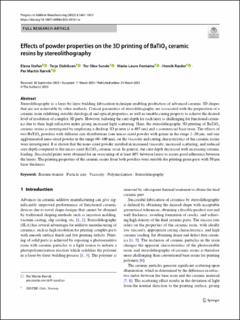| dc.contributor.author | Stefan, Elena | |
| dc.contributor.author | Didriksen, Terje | |
| dc.contributor.author | Sunde, Tor Olav Løveng | |
| dc.contributor.author | Fontaine, Marie-Laure | |
| dc.contributor.author | Ræder, Johan Henrik | |
| dc.contributor.author | Rørvik, Per Martin Ljønes | |
| dc.date.accessioned | 2024-02-05T09:30:40Z | |
| dc.date.available | 2024-02-05T09:30:40Z | |
| dc.date.created | 2023-03-30T15:42:14Z | |
| dc.date.issued | 2023 | |
| dc.identifier.citation | Progress in Additive Manufacturing. 2023, 8, 1641-1651. | en_US |
| dc.identifier.issn | 2363-9512 | |
| dc.identifier.uri | https://hdl.handle.net/11250/3115485 | |
| dc.description.abstract | Stereolithography is a layer-by-layer building fabrication technique enabling production of advanced ceramic 3D shapes that are not achievable by other methods. Critical parameters of stereolithography are associated with the preparation of a ceramic resin exhibiting suitable rheological and optical properties, as well as tunable curing property to achieve the desired level of resolution of complex 3D parts. However, tailoring the cure depth for each layer is challenging for functional ceramics due to their high refractive index giving increased light scattering. Here, the stereolithography 3D printing of BaTiO3 ceramic resins is investigated by employing a desktop 3D printer (λ = 405 nm) and a commercial base resin. The effects of two BaTiO3 powders with different size distributions (one micro-sized powder with grains in the range 1–20 μm, and one agglomerated nano-sized powder in the range 60–100 nm), on the viscosity and curing characteristics of the ceramic resins were investigated. It is shown that the nano-sized powder resulted in increased viscosity, increased scattering, and reduced cure depth compared to the micro-sized BaTiO3 ceramic resin. In general, the cure depth decreased with increasing ceramic loading. Successful prints were obtained for an overcuring of at least 40% between layers to assure good adherence between the layers. The printing properties of the ceramic resins from both powders were suitable for printing green parts with 50 μm layer thickness. | en_US |
| dc.language.iso | eng | en_US |
| dc.publisher | Springer | en_US |
| dc.rights | Navngivelse 4.0 Internasjonal | * |
| dc.rights.uri | http://creativecommons.org/licenses/by/4.0/deed.no | * |
| dc.subject | Viscosity | en_US |
| dc.subject | Viscosity | en_US |
| dc.subject | Keramer | en_US |
| dc.subject | Ceramics | en_US |
| dc.subject | Particle size | en_US |
| dc.subject | Particle size | en_US |
| dc.subject | Additive manufacturing | en_US |
| dc.subject | Additive manufacturing | en_US |
| dc.title | Effects of powder properties on the 3D printing of BaTiO3 ceramic resins by stereolithography | en_US |
| dc.title.alternative | Effects of powder properties on the 3D printing of BaTiO3 ceramic resins by stereolithography | en_US |
| dc.type | Peer reviewed | en_US |
| dc.type | Journal article | en_US |
| dc.description.version | publishedVersion | en_US |
| dc.rights.holder | © The Author(s) 2023. Published by Springer. | en_US |
| dc.source.pagenumber | 1641-1651 | en_US |
| dc.source.volume | 8 | en_US |
| dc.source.journal | Progress in Additive Manufacturing | en_US |
| dc.identifier.doi | 10.1007/s40964-023-00431-w | |
| dc.identifier.cristin | 2138610 | |
| cristin.ispublished | true | |
| cristin.fulltext | original | |
| cristin.qualitycode | 1 | |

